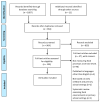Identification and Evaluation of Tools Utilised for Measuring Food Provision in Childcare Centres and Primary Schools: A Systematic Review
- PMID: 35409781
- PMCID: PMC8998327
- DOI: 10.3390/ijerph19074096
Identification and Evaluation of Tools Utilised for Measuring Food Provision in Childcare Centres and Primary Schools: A Systematic Review
Erratum in
-
Correction: Elford et al. Identification and Evaluation of Tools Utilised for Measuring Food Provision in Childcare Centres and Primary Schools: A Systematic Review. Int. J. Environ. Res. Public Health 2022, 19, 4096.Int J Environ Res Public Health. 2024 Apr 23;21(5):516. doi: 10.3390/ijerph21050516. Int J Environ Res Public Health. 2024. PMID: 38791865 Free PMC article.
Abstract
Background: Children aged 2-11 years spend significant hours per week in early childhood education and care (ECEC) and primary schools. Whilst considered important environments to influence children's food intake, there is heterogeneity in the tools utilised to assess food provision in these settings. This systematic review aimed to identify and evaluate tools used to measure food provision in ECEC and primary schools.
Methods: The Preferred Reporting Items for Systematic Reviews (PRISMA) was followed. Publications (2003-2020) that implemented, validated, or developed measurement tools to assess food provision within ECEC or primary schools were included. Two reviewers extracted and evaluated studies, cross checked by a third reviewer and verified by all authors. The Academy of Nutrition and Dietetics Quality Criteria Checklist (QCC) was used to critically appraise each study.
Results: Eighty-two studies were included in the review. Seven measurement tools were identified, namely, Menu review; Observation; Weighed food protocol; Questionnaire/survey; Digital photography; Quick menu audit; and Web-based menu assessment. An evidence-based evaluation was conducted for each tool.
Conclusions: The weighed food protocol was found to be the most popular and accurate measurement tool to assess individual-level intake. Future research is recommended to develop and validate a tool to assess service-level food provision.
Keywords: childcare; food provision measurement; menu review; primary school; weighed food.
Conflict of interest statement
The authors declare no conflict of interest.
Figures
References
-
- Movassagh E.Z., Baxter-Jones A.D.G., Kontulainen S., Whiting S.J., Vatanparast H. Tracking Dietary Patterns over 20 Years from Childhood through Adolescence into Young Adulthood: The Saskatchewan Pediatric Bone Mineral Accrual Study. Nutrients. 2017;9:990. doi: 10.3390/nu9090990. - DOI - PMC - PubMed
-
- Nicklaus S., Boggio V., Chabanet C., Issanchou S. A prospective study of food preferences in childhood. Food Qual. Prefer. 2004;15:805–818. doi: 10.1016/j.foodqual.2004.02.010. - DOI
-
- National Health Service United Kingdom Health Survey for England 2017. 2018. [(accessed on 5 November 2021)]. Available online: https://digital.nhs.uk/data-and-information/publications/statistical/hea....
Publication types
MeSH terms
LinkOut - more resources
Full Text Sources



